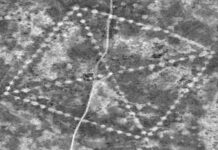Today, China may be associated with cheaply made toys and similar merchandise, but there should be no doubt that country has rich history of technological progress and discoveries. The most amazing ancient inventions from China are the so-called “four great inventions”.
1. The compass
The earliest use of lodestone compass was noted between the 2nd century BC and 1st century AD. It is recorded that Huangdi (The Yellow Emperor) defeated an enemy army by using a southward-pointing cart that helped him with the directing of his army in the fog during a legendary battle near Beijing. However, historians debate about whether this story was a myth or a real event. Later, around 1040-1044 there were references in dynasty books about a magnetic device used for navigation. The description was of floating iron in a bowl of water, which points to the south.

2. Gunpowder
Gunpowder was discovered around the 8th century by Chinese alchemists searching for an elixir of immortality. It was invented and gradually improved by Chinese alchemists in the Tang Empire (618–907), while it was extensively used by the Song Empire (960–1279) and adjacent empires during the 1200s. They improved gunpowder technology and they were able to construct a variety of weapons by using different formulas such as an primitive rockets, guns, small cannons, incendiary devices, chemical weapons, bombs, grenades, landmines, and smoke-making devices for camouflage. They also made fireworks and blasting powder for mining applications.

3. Papermaking
Papermaking has traditionally been traced to China at the beginning of the second century AD, when officials of the Imperial court during the Han Dynasty created a sheet of paper. The paper was composed of rags and the fibers of trees and plants. To make a sheet of paper, these kinds of substances were repeatedly soaked, pounded, washed, boiled, strained and bleached. The mash was later dried in a frame. The result was good quality writing material that was easier to produce on a large scale.

4. Printing
Before the emergence of the printing technique, manuscripts were all handwritten by scholars. It is known that the block printing technique was used near the end of the Han Empire (206 BC – 220 AD) both for printing on paper and for printing designs on cloth. Much later, the printing techniques greatly advanced. A man name as Bi Sheng (970-1051) is credited with being the inventor of ceramic movable type printing and he is called the “father of typography.”

Other Inventions Worthy of Mention
5. The Mechanical Clock
In 725 AD, a Buddhist mathematician and monk invented an astronomical instrument which also worked as a clock. The internal mechanism that contained a network of wheels, hooks, pins, shafts, locks and rods was water-powered, as a stream of falling water drove a wheel through a full revolution in twenty-four hours. Most of the parts were made out of gold and bronze. A bell chimed automatically on the hour, while a drumbeat marked each quarter-hour.

6. The Crossbow
Crossbows were a significant step in people’s ability to wage war. Archery was considered as a highly skilled craft that had to be learned for years, while the crossbow could be mastered by new recruits only after a few weeks. The earliest mentions of the crossbow come from the 6th century BC in ancient China. Also, bronze crossbow bolts that date to the mid-5th Century BC have been discovered in burial sites around China and even some handheld crossbows from the 6th century BC. Around the second century, the Chinese also developed repeating crossbows which could rapidly fire multiple bolts.

7. Seismoscope
A seismometer (or seismograph) is a scientific instrument that measures distant earthquakes and volcanic activity through the tiny movements of the ground that they cause. The first seismometer was invented nearly 2,000 years ago in China. It is known as Zhang Heng’s seismoscope. His device had eight tubes in the shape of a dragons’ head. During an earthquake a bronze ball would fall from one of the tubes to the mouth of a metal frog. The position of the frog indicated the orientation of the seismic wave. Scientists cannot specifically explain how the device worked, but they know that the eight mobile arms raised a catch via a crank, and a lever, which released the ball. The device probably also included a pendulum hung from a bar. This could mean that the driving force was inertia – a small movement in the pendulum perhaps triggered the motion that was transformed into a slight force on the correct lever.
















